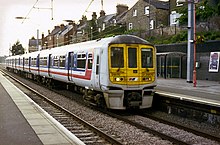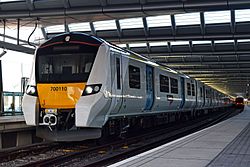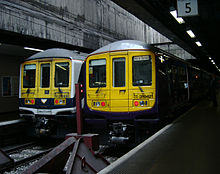Thameslink
| Thameslink | |
|---|---|
|
Thameslink train at Blackfriars station
| |
|
Route network plan 2020 with planned
extension to Maidstone East | |
| Gauge : | 1435 mm ( standard gauge ) |
| Power system : | 750 V = |
| Power system : | 25 kV, 50 Hz ~ |
Thameslink is a public transport system in London that connects places in the London area with the city center in a north-south direction. While the trains outside London run together with the rest of the regional traffic, the system in the city area is similar to a S-Bahn . The core of the network is the trunk line between St Pancras and Blackfriars , which runs through the Snow Hill Tunnel . The Thameslink trains run to Bedford , Peterborough and Cambridge in the north and to Horsham , Brighton , Sevenoaks and Rainham in the south. Gatwick and London-Luton airports are also served. The route belonged to Network SouthEast until it was dissolved in 1994, when British Rail was privatized by the railway company Govia . From April 1, 2006 to September 13, 2014, operations were run by First Capital Connect and, since September 14, 2014, by Govia Thameslink Railway . Thameslink transports around 40 million travelers per year.
Route network
Northern part

The original northern section corresponds to the formerly so-called "Bedpan" - (literally "bedpan") connection from Bedford via Luton to London St Pancras on the Midland Main Line .
Since 2018, the East Coast Main Line to Peterborough via Welwyn Garden City and Stevenage and the branch to Cambridge have also been part of the Thameslink network. At St Pancras they are connected to the trunk line via the Canal Tunnels.
Trunk line
The Snow Hill Tunnel , the central link through London, was reopened to passenger traffic in 1988 after 50 years. For Thameslink, older tunnel sections, including the Widened Lines built by the Metropolitan Railway , were merged into a new route. The through trains no longer stopped in St Pancras station, but in the underground station King's Cross Thameslink .
From 2004 to May 2005 the trains between King's Cross and St Pancras were separated as tunnels for the Channel Tunnel Rail Link (CTRL), the new Eurostar route from the Eurotunnel via Stratford International to St Pancras, were built in this area. Since the opening of the second section of the CTRL in 2007, the Thameslink trains have stopped at a new Thameslink station just below St Pancras station.
The following stations are served from north to south in central London:
- King's Cross Thameslink under Pentonville Road is near King's Cross and St Pancras train stations , but only accessible by road or a pedestrian tunnel. In 2007 the station was replaced by a new building under St Pancras station.
- Farringdon ; Here you can change to the Circle Line , the Hammersmith & City Line and the Metropolitan Line of London Underground . At Farringdon station, the system changes between 25 kV AC from the north and the busbar system with 750 V DC from the south.
- City Thameslink , which was initially called St Paul's, but was then renamed in order to avoid confusion with the distant underground station St. Paul’s on the Central Line .
- Blackfriars , with transfer options to other railway lines and to the District Line and the Circle Line of London Underground
- London Bridge , where there are also transfer options to other railway lines such as the Northern Line and the Jubilee Line of London Underground.
Thameslink is, apart from the underground and the West London Line , which runs further to the west, the only railway line that runs through London instead of ending in one of the head stations. Because of this crossing of the center, the route has been included in the route network maps of the Underground since its reopening alongside the North London Line . Since the latter has been part of the Overground network, the Thameslink route has been removed from the subway plans. Crossrail , a similar east-west line, is under construction.
A branch line ran from Farringdon via Barbican to Moorgate until 2009 .
Southern part
In the south the line branches in two directions; The main line runs from London Bridge station via East Croydon and Gatwick Airport to Brighton , the branch line turns off after Blackfriars to Elephant & Castle and then leads back to Streatham via Streatham , Tooting , Wimbledon , Sutton and Mitcham Junction. Some trains coming from Brighton turn onto the branch line after East Croydon and only meet the main line again in Blackfriars, so that not all trains from Gatwick to London stop at London Bridge.
Originally the branch line ran via Elephant & Castle and Streatham to West Croydon , then on to Carshalton Beeches and Sutton, Epsom, Leatherhead, Effingham Junction and Guildford . After the privatization of the British railways, the branch line first ended in West Croydon and was then completely changed, since 1995 West Croydon has no longer served.
vehicles
The rolling stock of Thameslink existed until the mid-2010s from 74 trains of the series 319 , the 1987 to 1990 of BREL (now Bombardier Transportation were built) in Derby. These are two-system multiple units with four cars each that can carry 289, 308 or 319 passengers. The units are equipped with roof pantographs for the supply from the overhead line with 25 kV AC voltage and with side pantographs for operation with the busbars coated from above with 750 V DC voltage according to the Southern Railway system.
The British government has been renewing and expanding the Thameslink fleet since 2015. For this, Siemens received the order, together with the consortium Cross London Trains (XLT) , consisting of Siemens Project Ventures GmbH, Innisfree Limited and 3i Infrastructure plc, to deliver approx. 1200 wagons of the 700 series , as the British Ministry of Transport (DfT) on 26. June 2013 announced. This was previously considered in 2011. The urging of some local politicians and British railway unions, for structural and regional political reasons, not to award the billion-dollar contract to the best foreign bidder, but to the previous, but now only second-placed supplier, Bombardier, was unsuccessful. At the beginning of June 2013, the Ministry of Transport announced that Siemens would be awarded the contract.
In addition, 40 train units of the 365 series were refurbished and brought up to date with the latest technology, whereby another reason for the refurbishment was the handicapped-accessible conversion. The units were given handicapped accessible toilets and parking spaces for wheelchair users. The program, which has been running since the spring of 2013, was paid £ 30 million. The railcar units should be fully operational again in autumn 2016.
Expansion of the trunk line
In October 2007, under the title Thameslink 2000, work began on expanding the main line. As part of a two-stage program that will run until 2015, £ 5.5 billion should be invested. In a first stage, the platforms at 23 stations were to be extended by December 2011. A new double-track bridge was planned in the area of Borough Market. In a second stage, London Bridge station was to be fundamentally rebuilt after the 2012 Olympic Games . At the station, among other things, the number of through tracks for Thameslink trains was to be increased from 6 to 9 and the number of end tracks for this was to be reduced from 9 to 6. In addition, tunnels and overpass structures were planned. In the future, the station should handle 86 trains per hour and direction at peak times. Two additional tracks are planned between London Bridge and Metropolitan Junction.
Along with a new signaling system, additional lines were to be offered and the train frequency in the trunk line tunnel increased from 20 to 24 trains per hour and direction. An ETCS equipment was not planned, according to Network Rail. A total of up to 1300 new vehicles should be procured.
In 2009 it was decided to introduce automatic operation (ATO) on the Thameslink trunk line. Analyzes had shown that this was the only way to achieve the desired performance of 24 trains per hour and direction with the required quality. In 2010 Network Rail announced that it would use ETCS for this, with national extensions (package 44) for automatic operation (ATO) being used. In order to limit the equipment risk, a conventional light signaling system with conventional train control ( AWS / TPWS ) is installed in several stages , which allows around 18 trains per hour. ETCS should build on this. Several solid-state interlockings from the 1990s are to be replaced by an electronic interlocking .
The first expansion phase was completed in spring 2012. ETCS-ATO operations between Kentish Town and Elephant & Castle are scheduled to commence in January 2018 and on the other sections in the course of 2018.
On June 27, 2013, Siemens received the order to deliver 1,140 cars. The value of this order is 1.8 billion euros. It was the company's largest order in Great Britain to date. With ETCS Level 2 in automatic operation (ATO) and a driver assistance system, an output of 24 trains per hour and direction should be provided. For the first time, ETCS is to be used in conjunction with automatic driving operation (ATO), for which national ETCS packages (package 44) are also to be used. Among other things, capacity-critical areas, for example in front of platforms and junctions, are to be divided into several sections using ETCS in order to enable faster advancement. ETCS is also used to signal information about side-selective door control and about changing the power system.
In automatic mode, the driver's function is essentially limited to monitoring the change of passengers and initiating departure (using the start button). Train stops should then take place with an accuracy of ± 50 centimeters. After a train has reported a stop on the platform, the control system should transmit a stopping time and the planned travel time to the next station. The control technology is to be integrated into a national system for rail traffic control by Network Rail.
Outside the core area, the ETCS vehicle equipment is operated with the national train control systems AWS and TPWS (ETCS Level National Train Control). A driver assistance system that is connected to a central control computer via public mobile radio should also give recommendations.
In addition, Siemens is also taking on the long-term maintenance of the trains and is building two new depots in Three Bridges and Hornsey . Starting in 2014, the vehicles will be built at the Siemens plant in Krefeld, with the final equipment at Talbot Services in Aachen. The Desiro City Thameslink vehicles are supplied as eight and twelve-part two-system trains for 750 V direct and 25 kV alternating voltage. The maximum speed is 160 kilometers per hour.
Most of the ETCS line equipment was installed in mid-2015 and the expansion of the GSM-R system was well advanced. The Radio Block Center has been tested in laboratories. ETCS test drives with the new trains are scheduled to begin in August 2016. The radio network has been supplemented by additional base stations of a new design and 16 radio field amplifiers, is fully redundant, uses partly conventional antennas and partly slotted cables. The first ETCS test drives took place between October 18 and November 1, 2015 with an ETCS test train of the 313 series . Test drives with the 700 series should follow from late summer 2016.
The first trains of the 700 series were used in passenger service at the end of June 2016. On July 30, 2016, the first of these multiple units drove with ETCS over the main line at night. Tests with ATO should follow in September 2016. At the beginning of 2017, ATO test drives took place with two successive trains.
With the new trains, the number of seats on the section in the heart of London should be expanded by around 80 percent by 2019 compared to 2015. In May 2018, the rush hour traffic service was expanded to 18 trains per hour and direction. From December 2018 20 trains per hour and direction should be offered, from May 2019 22, from December 2019 finally 24 trains per hour and direction. Trains with eight or twelve cars are planned. Due to problems with the timetable change in May 2018, the further introduction was delayed in order to maintain punctuality. Since May 2019, 20 trains per hour and direction have been driven. ATO is required for additional performance increases. ATO has been tested on regular service trains since December 11, 2019. A further increase in performance is planned from December 2020.
According to the operator, the £ 6.5 billion conversion of the line, which also includes the complete rebuilding of London Bridge station, the new 700 series trains and other expansion measures, is the largest expansion of an operating railway line ever had been tried.
To optimize operations, a networked driver assistance system is used that extends up to 20 kilometers beyond the city limits and obtains information from a control system supplied by Hitachi.
Building tomorrow's railway today
The Thameslink Railway launched a campaign under the name Building tomorrow's railway today , which aims to improve the Thameslink in all areas. An important part of this is the recruitment of trainees, of whom a total of 184 will be trained as train drivers in 2015 in a time-consuming training program. In addition, investments were made in new clothing and equipment with iPads for better information transfer for Thameslink employees. The capacity of the line, especially in rush hour traffic to London, is to be improved by expanding the offer. In addition, around 50 million pounds will be invested in the renovation of stations in order to improve and expand the entire existing station infrastructure.
Individual evidence
- ↑ Govia wins Thameslink rail franchise - BBC News. Retrieved September 1, 2016 (UK English).
- ^ Peterborough and Cambridge join Thameslink network. February 26, 2018, accessed May 7, 2020 .
- ^ Department of Transport (DfT): Rail passengers to benefit from 1,200 new carriages , press release June 16, 2011. Accessed August 17, 2011.
- ↑ Public transport up-to-date: Inexpensive or protectionism - England is arguing about a rail contract ( memento of the original from January 18, 2012 in the Internet Archive ) Info: The archive link was automatically inserted and not yet checked. Please check the original and archive link according to the instructions and then remove this notice. (PDF; 754 kB). In: ÖPNV aktuell 60/11 of July 29, 2011. Accessed on August 17, 2011.
- ↑ Thameslink deal close to completion. In: press release. Department for Transport, June 14, 2013, accessed June 18, 2013 .
- ↑ Refurbishment of the 365 trains
- ↑ a b Cross-city expansion gets underway . In: Railway Gazette International . tape 164 , no. 3 , 2008, ISSN 0373-5346 , p. 172 f .
- ↑ a b c d e f g Vince McLellan: Thameslink resignalling gathers pace . In: Railway Gazette International . tape 168 , no. 5 , 2012, ISSN 0373-5346 , p. 47-50 .
- ↑ a b Chris Jackson: Intelligent train management will cut costs . In: Railway Gazette International . tape 167 , no. 6 , 2011, ISSN 0373-5346 , p. 61-64 .
- ↑ a b c d e f Paul Booth: ETCS and ATO through the Thameslink core . In: Railway Gazette International . tape 171 , no. 9 , 2015, ISSN 0373-5346 , p. 33-37 .
- ↑ Frank Walenberg, Rob te Pas, Lieuwe Zuchterman: Making progresses towards standardized train control . In: Railway Gazette International . tape 168 , no. 3 , 2012, ISSN 0373-5346 , p. 35-38 .
- ^ David Bickell: Thameslink signaling update. In: railengineer.uk. March 22, 2017, accessed March 26, 2017 .
- ↑ Thameslink contract signed: Siemens supplies trains for around 1.8 billion euros. June 27, 2013, accessed June 28, 2013 .
- ^ Clive Kessell: Thameslink Telecoms . In: Rail Engineer . No. 3 , March 2019, ZDB -ID 2907092-2 , p. 46-49 ( online [accessed April 26, 2019]).
- ^ Thameslink ETCS makes progress . In: Railway Gazette International . tape 172 , no. 2 , 2016, ISSN 0373-5346 , p. 43 .
- ↑ Major Thameslink project: Siemens trains start operating in London. (PDF) In: siemens.com. Siemens, June 24, 2016, accessed June 24, 2016 .
- ↑ ETCS goes live on Thameslink. In: globalrailnews.com. August 3, 2016, accessed February 24, 2017 .
- ↑ Clive Kessell: UK signaling - A 2017 update. In: railengineer.uk. February 23, 2017, accessed March 10, 2017 .
- ↑ a b Chris Jackson: Class 700 is on track . In: Railway Gazette International . tape 171 , no. 5 , 2015, ISSN 0373-5346 , p. 44 f .
- ↑ Thameslink Ramp-Up begins . In: Modern Railways . tape 77 , June 2018, ISSN 0026-8356 , p. 52 f .
- ^ Thameslink going automatic . In: Modern Railways . tape 77 , no. 856 , January 2020, ISSN 0026-8356 , p. 16 .
- ↑ Chris Jackson: Reaping the benefits of C-DAS . In: Railway Gazette International . tape 174 , no. 2 , 2018, ISSN 0373-5346 , p. 3 .
- ^ Thameslink: Driver Training
- ↑ Information page for better staff equipment
- ↑ Information page to improve the range of journeys and train stations





